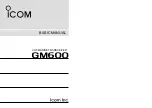
DW1000 User Manual
© Decawave Ltd 2017
Version 2.12
Page 226 of 242
In this scheme the error in the measured
T
prop
is given by the following: -
Table 65: Typical clock induced errors in SS-TWR time of flight estimation
clock error
T
reply
2 ppm
5 ppm
10 ppm
20 ppm
40 ppm
100 µs
0.1 ns
0.25 ns
0.5 ns
1 ns
2 ns
200 µs
0.2 ns
0.5 ns
1 ns
2 ns
4 ns
500 µs
0.5 ns
1.25 ns
2.5 ns
5 ns
10 ns
1 ms
1 ns
2.5 ns
5 ns
10 ns
20 ns
2 ms
2 ns
5 ns
10 ns
20 ns
40 ns
5 ms
5 ns
12.5 ns
25 ns
50 ns
100 ns
It can be seen that as T
reply
increases and as the clock offset increases the error in the time-of-flight
estimation increases to the point where the error is such as to render the estimation very inaccurate. For
this reason, SS-TWR is not commonly used but it is worthy of examination for particular use cases where
tight tolerance clocks are used and the communication range is relatively short.
Table 66: Typical clock induced error in SS-TWR time-of-flight estimation using actual IEEE80.15.4-2011
UWB frame lengths
clock error
T
reply
2 ppm
5 ppm
10 ppm
20 ppm
40 ppm
211 µs total
6.81 Mbps
64 Symbol Preamble
96 µs response delay
0.2 ns
0.5 ns
1.1 ns
2.1 ns
4.2 ns
275 µs total
6.81 Mbps
128 Symbol Preamble
96 µs response delay
0.3 ns
0.7 ns
1.4 ns
2.8 ns
5.5 ns
403 µs total
6.81 Mbps
256 Symbol Preamble
96 µs response delay
0.4 ns
1 ns
2 ns
4 ns
8 ns
Note: An error of 1 ns is equivalent to a 30 cm error in measured distance.
Advantages
Drawbacks
Only one message exchange required which saves
time & power.
As T
reply
increases and clock offsets increase the
estimated time-of-flight becomes very inaccurate.
If T
reply
is kept short and accurate crystals are used
then time-of-flight estimation may be accurate
enough for certain use cases.
















































